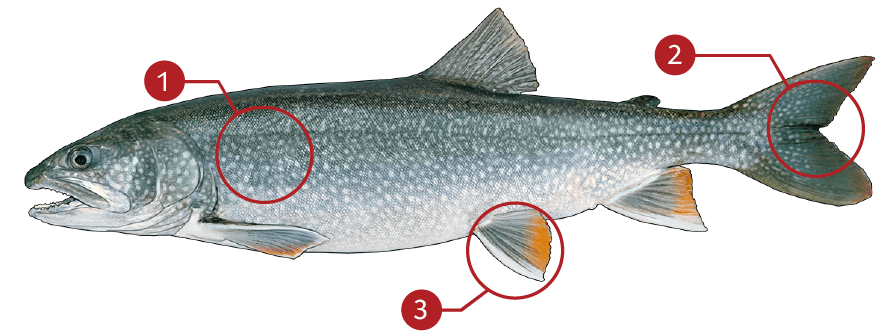LAKE TROUT
How to identify a Lake Trout
It is classified taxonomically with the chars, although some scientists prefer to place it in a genus of its own. Like other chars it has white leading edges on all the lower fins and light colored spots on a dark background, instead of the dark spots on a light background which is characteristic of salmon and trout. The body is typically grayish to brownish with white or nearly white spots which extend onto the dorsal, adipose, and caudal fins. There are no red, black or haloed spots of any kind. It has a more deeply forked tail than other chars, and several rows of strong basibranchial teeth which are weak, less numerous, or absent in other chars. It is very large char known to grow over 100 lb. (45 kg).It has been crossed with the brook trout to produce a hybrid known as the “splake” or “wendigo trout.” The hybrid lacks the deep fork in the tail and more closely resembles the brook trout in most respects. There are 65-85 pyloric caeca in the hybrid versus 93-208 in the lake trout and 23-55 in the brook trout.
Where to catch Lake Trout
The lake trout is found throughout most of Canada and well into Alaska as well as the Great Lakes and in sections of the western U.S. where it has been introduced. In the southern portions of its range, or where introduced south of its native range, it seeks out the cooler waters of deep lakes. In northern lakes it may occur in either shallow or deep water. The siscowet, one of three recognized subspecies, is found in Lake Superior at a depth of 300-600 ft. (91-183 m). It is called a fat by commercial fishermen because the flesh is exceedingly fat and oily compared to the other two subspecies. Of all the chars, it is the least tolerant of salt water and is the only freshwater fish ranging into the far north of Canada and Alaska that has apparently not crossed the Bering Strait.
IDENTIFICATION

| |
Dark greyish-green body with irregular shapped white splotches over most of the body |
| |
White spots which extend onto the dorsal, adipose, and caudal fins |
| |
White leading edges on all the lower fins and light colored spots on a dark background |
TARGET AREAS
|
|
Acknowledgements: We thank TAKEMEFISHING.org (www.takemefishing.org), Wisconsin Department of Natural Resources, Indiana Department of Natural Resources for their contributions to these FISH FACTS.

